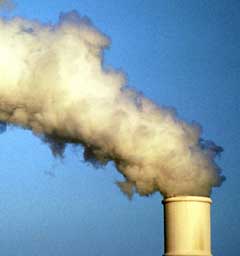Atmospheric Inputs
Pollution Tutorial

Pollutants dispersed through smokestacks like this can remain aloft for long periods of time, travel great distances and impact individuals and ecosystems many tens, or hundreds of miles away.
Industrial facilities often discharge pollutants into the atmosphere, typically through some type of smokestack. These airborne pollutants (hydrocarbons, metals, etc.) can travel long distances. The pollutants are then deposited on surfaces (dry deposition) or washed out of the atmosphere in rain or snowfall (wet deposition).
Although the pollutants may have originated from a point source of air pollution such as a factory, the long-range transport and multiple sources of the pollutant make it a nonpoint source of pollution. Scientists estimate that approximately two-thirds of the lead and mercury and over half of the other trace elements that enter the Great Lakes originate from atmospheric inputs.
Acid rain has also become a major concern in some areas of the United States. Acid rain is created when sulfur dioxide and nitrogen oxides are discharged from industrial plants that burn fossil fuels like coal, oil, and natural gas. These compounds react with water, oxygen, and other atmospheric compounds to form acid rain.
Acid rain causes a cascade of effects that harm or kill fish and other aquatic organisms. As acid rain flows over and through soils, it releases aluminum into lakes and streams. Increased levels of aluminum are very toxic to fish. In addition, increased levels of aluminum cause fish to become chronically stressed. While chronic stress may not kill individual fish, it leads to lower body weight and smaller size, making the fish less able to compete for food and habitat.
Acid rain also damages forests. For example, acid rain can damage the surfaces of leaves and needles, reduce a tree's ability to withstand cold, and inhibit plant germination and reproduction. Prolonged exposure can cause forest soils to lose valuable nutrients like calcium and magnesium. Lack of nutrients causes trees to grow more slowly or to stop growing altogether.
Pollution Lessons
- Welcome
- A Brief History of Pollution
- Point Source
- Nonpoint Source
- Urban and Suburban Areas
- Agricultural Operations
- Atmospheric Inputs
- Forestry and Mining Operations
- Marinas and Boating Activities
- Nutrients
- Suspended Sediments
- Pesticides and Toxic Chemicals
- Bacteria, Viruses, and Trash
- Research, Monitoring, and Assessment
- Controlling Nonpoint Source Pollution
- What You Can Do
- References
- Roadmap to Resouces
- Subject Review (PDF)
Categories of Pollution
Pollutants from Nonpoint Sources
